To elaborate on the development of Chinese gold jewelry, I had to take an archaeological journey from the Shang Dynasty (1766 – 1122 B.C.) to the Qing Dynasty (1644 – 1911 A.D.). Looking at ancient maps, China started out small. Amid tribal wars, power struggles and consolidation made boundaries fluid. Ideas were exchanged.
Through collision and synthesis Chinese goldsmiths innovated, most notably when they made hair pins and crowns. Gold leaf, repoussé, casting, moulding, welded beading, filigree, drawn work, and plating have all been seen in excavated pieces, as well as those for sale at auction houses.
This Shang gold hair pin came from a grave in Liujiahe, near Beijing. Now famous in archaeological circles, the gold found here proves that metalworking, and therefore the Bronze Age started in China 4000 years ago, 800 years before Europe. What you see is the pin alone. Cast from a mould, there is a small, straight tenon joint at the front. This fit into the mortise of the pin’s ornament.
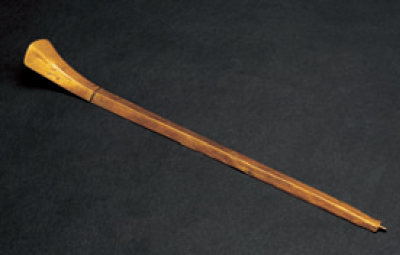
During the Spring-and-Autumn subperiod of the Warring States Dynasty (475 – 221 B.C.), this bird final to a royal crown was attributed to the Xiōngnú, a nomadic Mongol tribe who fought and conquered Chinese peoples to form the Han Dynasty (206 B.C. – 220 A.D.). The finial was also cast, but you can now see colored-stone inlay techniques. Welded beading in other jewelry was also excavated at the same grave in Ordos, Inner Mongolia.
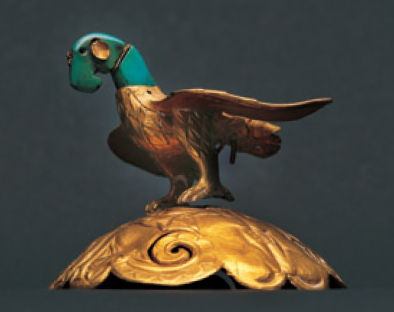
When the Xiōngnú consolidated more territory during the Han Dynasty, the ideals they placed upon gold began to interact with Western tribal cultures, who cherished jade. The evidence can be seen in hair ornaments unearthed in Xigoupan, Mongolia, where jade was paired with gold.
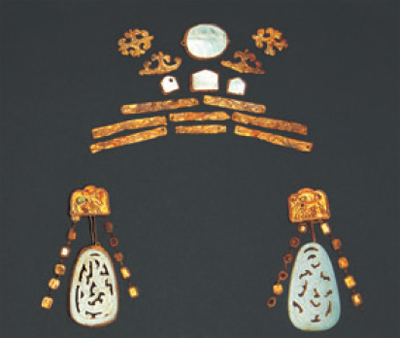
After the Han Dynasty, three Yan Dynasties followed: Former, Latter, and Northern (265 – 420 A.D.), the Murong branch of Xianbei peoples established control and made beautiful gold headdress ornaments with dangling leaves called buyao, which means “shake as you go.” Here are examples of three ornaments and a full crown. (An aside: I am amazed at how the crown’s design resembles the Dogon chief’s crown at The Creative Museum.)
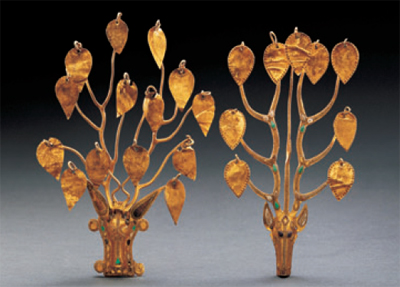
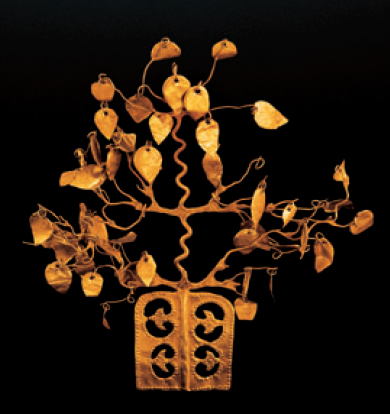
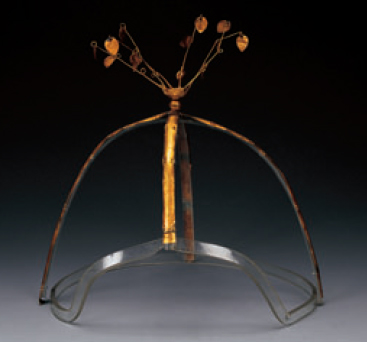
Baodianzhuang inlay, where stones were placed inside a gold casing, was popular among the aristocracy of the Yuan Dynasty (1271 – 1368 A.D.). A full set of 7 gold hair ornaments was found in Huangpi, Hubei Province in Central China, just north of Hunan. Two gold hair pins, hair slides, ornaments, and the back of a comb were originally inlaid with precious stones, now missing. Because the pieces are not the same size, they could not have been worn symmetrically.
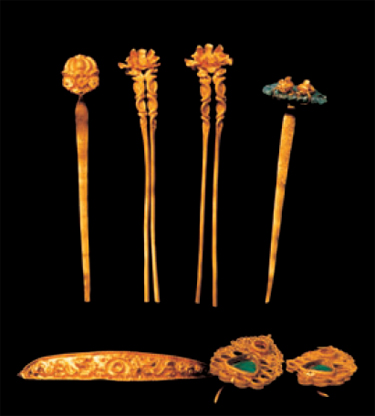
Two of the most beautiful crowns ever found were from the Wanli Emperor in the Ming Dynasty (1368 – 1644 A.D.), who ascended the throne at age 9. He was buried with a spectacular crown. Artists coiled and welded woven gold mesh, which served as the background to a gold dragon adorned with pearls and 20 other jewels.
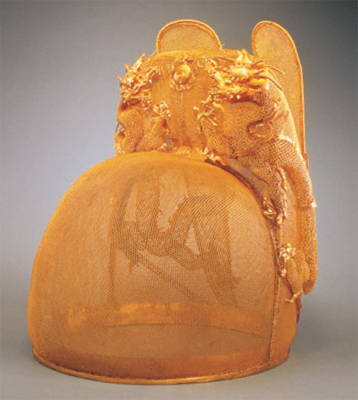
One of Wanli’s two empresses, Xiaoduan, was buried with a kingfisher crown that boasted 6 phoenixes, 6 dragons, 128 rubies and sapphires, and 5449 pearls.
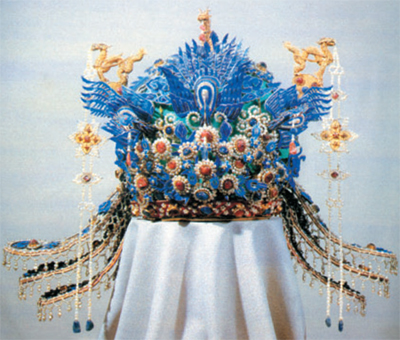
In 1521, the wife of a county secretary was found with a jewel-encrusted gold phoenix hair pin in her grave. As hair jewelry was a strict delimiter of social status, this shows a market change. Anyone with access to money could wear gold jewelry.
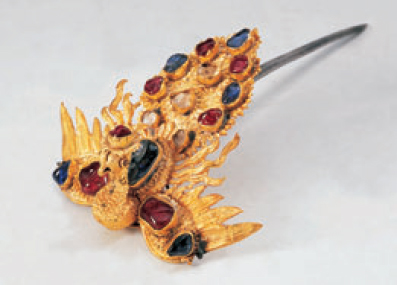
The Qing Dynasty (1644 – 1911 A.D.) started with the intent to carry on Ming traditions, however, the Imperial family came from the Jurchen ethnic group from Northeast China, or Manchuria. They consolidated the most land, including Mongolia, and formed alliances with the Mongolian aristocracy. Their religion was Tibetan Buddhism and included shamanistic sacrifices.
In 2008, Sotheby’s had an auction of Qing gold hair pins. Keeping with tradition, each hair ornament was decorated with auspicious symbols, denoting social status. Many were shaped like ruyi, a back-scratching sceptre dating back to the Han Dynasty. Here are some pictures and prices:
Gold filigree borders a ruyi-shaped head with a pearl in the center. Six symbols are attached to the top by gold wire, including 4 dragons and a wan symbol, wishing the wearer prosperity and good fortune. Sale price: $15,000.
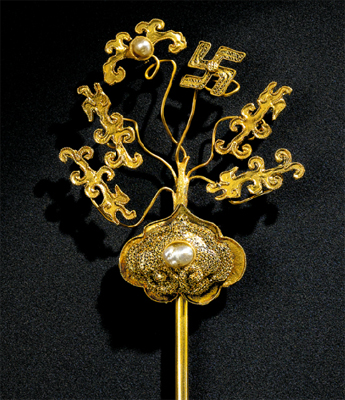
Five hammered gold petals separate 5 gold filigree petals with inlaid turquoise. A winged boy flying in the clouds decorates the pin itself. Sale price: $8000.
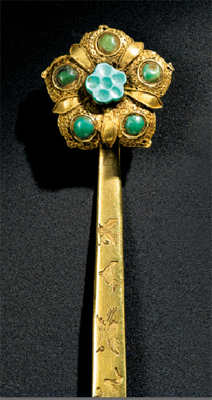
A meticulous gold-filigreed phoenix with pearls in perfect condition. I see Ming Dynasty influence in this piece. Sale price: $66,000.
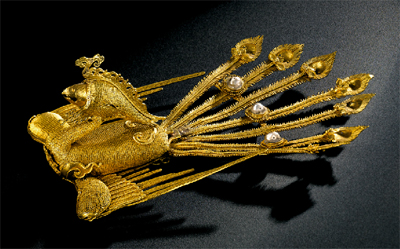 You may find exquisite samples of modern jewelry at Sweet-Madness.com.
You may find exquisite samples of modern jewelry at Sweet-Madness.com.
Happy Chinese New Year. :-) It’s the Year of the Dragon. Celebrate by choosing some affordable Chinese Dragon Jewelry.
कंघी
Source: Ancient Cultures of Jewelry and Ornamentation by Yang Boda: Arts of Asia, 2008
You may also examine




Thank’s Barbara – this posting is the crown for that Chinese Dragon Year 2012 – very well researched – beautiful !
I’m honored. Thank you.
Hi,Dear Anne
I am a collector of ancient Chinese metal jewelry. Thanks for sharing so many thoughts and pictures with us. I am writing a Chinese book on this topic. Can I have your email? I would like to seek your opinion on some chapters. thanks